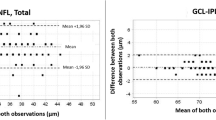Abstract
Purpose
To compare optic nerve head topographies measured using a Heidelberg retina tomograph I (HRT) and a retinal thickness analyzer (RTA) and thereby to determine clinical agreement between the two devices. Also, to investigate the reproducibility of optic nerve head measurements using the HRT and RTA.
Methods
The study included 50 normal left eyes of 50 white adults. Ophthalmologic examination, keratometry, fundus photography, and examination with HRT and RTA were performed. To determine reproducibility, 10 volunteers had repeated examinations after a week. Mean (SD), median, and 5th and 95th percentiles were calculated for the HRT and RTA measurements and differences in measurements between HRT and RTA were tested for statistical significance. Clinical agreement was assessed with limits of agreement and reproducibility by a repeatability coefficient and intraclass correlation coefficient (ICC).
Results
Statistically significant differences (P < 0.05) between measurements by HRT and RTA were observed for all topographic parameters, except for rim area (P = 0.051) and height variation contour (P = 0.054). The limits of agreement between HRT and RTA were wide. The repeatability coefficient for HRT was good (≤0.10) for all parameters, except for retinal nerve fibre layer (RNFL) cross-sectional area (0.28). The repeatability coefficient for RTA was >0.10 for cup area (0.15), rim area (0.19), maximum cup depth (0.13), height variation contour (0.11), and RNFL cross-sectional area (0.14). The ICC was good (≥90%) for all parameters, except for mean RNFL thickness (89%) for HRT, and height variation contour (84%) for RTA.
Conclusion
The observed differences within the limits of agreement were clinically important. Therefore, the two devices cannot be used interchangeably in clinical practice.


Similar content being viewed by others
References
Jonas JB, Budde WM, Panda-Jonas S (1999) Ophthalmoscopic evaluation of the optic nerve head. Surv Ophthalmol 43:293–320
Sommer A, Katz J, Quigley HA et al (1991) Clinically detectable nerve fiber atrophy precedes the onset of glaucomatous visual field loss. Arch Ophthalmol 109:77–83
Zeyen TG, Caprioli J (1997) Progression of disc and field damage in early glaucoma. Arch Ophthalmol 111:62–65
Greenfield DS (2002) Optic nerve, retinal nerve fiber analyzers in glaucoma. Curr Opin Ophthalmol 13:68–72
Janknecht P, Funk J (1994) Optic nerve head analyser and Heidelberg retina tomograph: accuracy and reproducibility of topographic measurements in a model eye and volunteers. Br J Ophthalmol 78:760–768
Rohrschneider K, Burk RO, Kruse FE et al (1994) Reproducibility of the optic nerve head topography with a new laser tomographic scanning device. Ophthalmology 101:1044–1049
Zeimer R, Shahidi M, Mori M et al (1996) A new method for rapid mapping of the retinal thickness at the posterior pole. Invest Ophthalmol Vis Sci 37:1994–2001
Bland JM, Altman DG (1986) Statistical methods for assessing agreement between two methods of clinical measurement. Lancet 307–310
Bland JM, Altman DG (1999) Measuring agreement in method comparison studies. Stat Methods Med Res 8:135–160
Blackmann NJM (2004) Reproducibility of clinical data I: continuous outcomes. Pharmaceut Statist 3:99–108
Itai N, Tanito M, Chihara E (2003) Comparison of optic disc topography measured by retinal thickness analyzer with measurement by Heidelberg retina tomograph. Jpn J Ophthalmol 47:214–220
Hoffmann EM, Medeiros FA, Kramann C et al (2006) Repeatability and reproducibility of optic nerve head topography using the retinal thickness analyzer. Graefe’s Arch Clin Exp Ophthalmol 244:192–198
Hoffmann EM, Bowd C, Medeiros FA et al (2005) Agreement among three optical imaging methods for the assessment of optic disc topography. Ophthalmology 112:2149–2156
Martinez de la Casa JM, Garcia Feijoo J, Castillo Gomez A et al (2004) Correlations between retinal thickness analyser (RTA) and confocal scanning laser tomography (HRT) in optic disc analysis. Arch Soc Esp Ophtalmol 79:21–25
Author information
Authors and Affiliations
Corresponding author
Rights and permissions
About this article
Cite this article
Rekič, A., Breznik, M. & Cvenkel, B. Comparison of optic nerve head topography in healthy adults using a Heidelberg retina tomograph and retinal thickness analyzer. Int Ophthalmol 27, 1–9 (2007). https://doi.org/10.1007/s10792-007-9051-z
Received:
Accepted:
Published:
Issue Date:
DOI: https://doi.org/10.1007/s10792-007-9051-z




